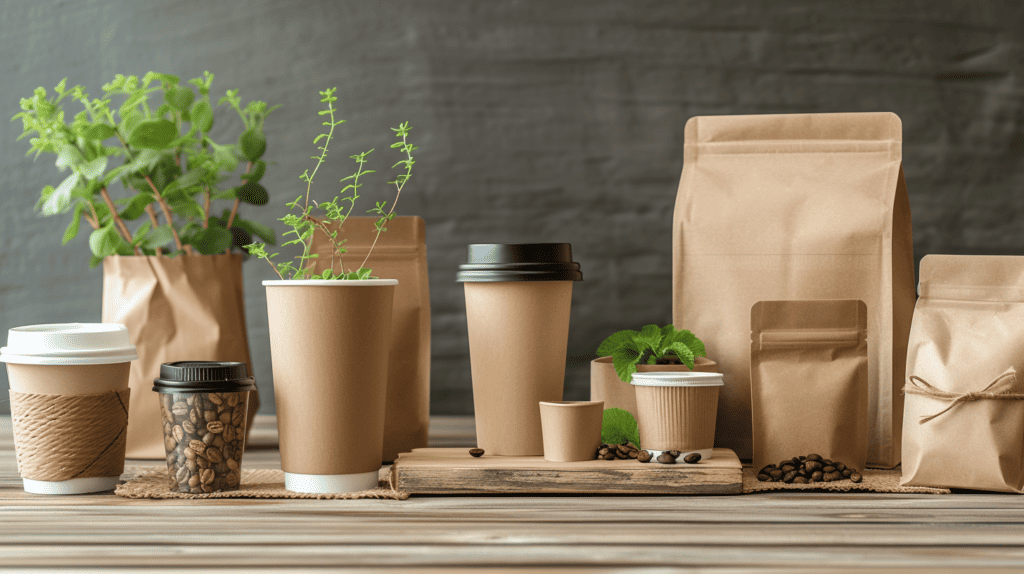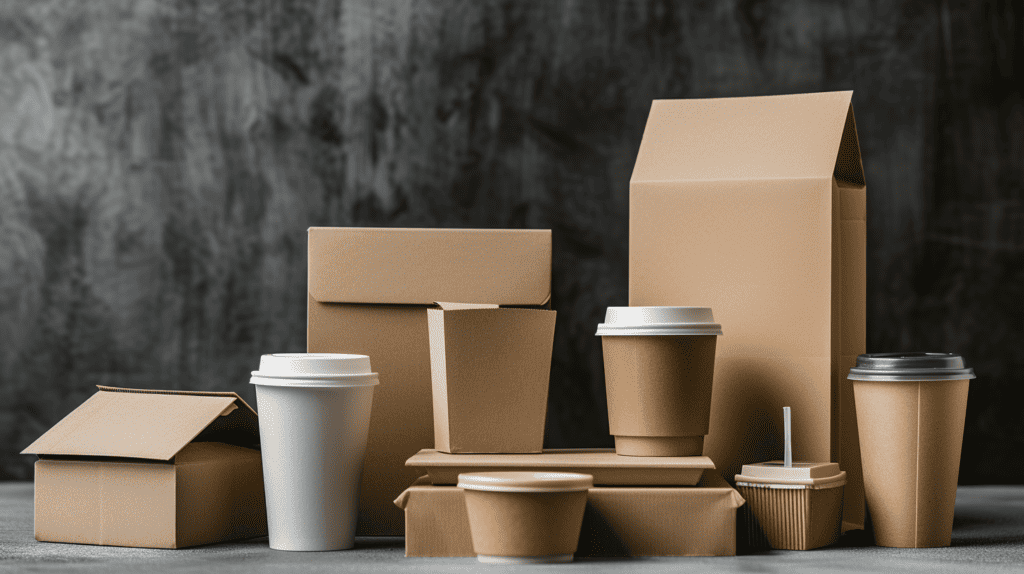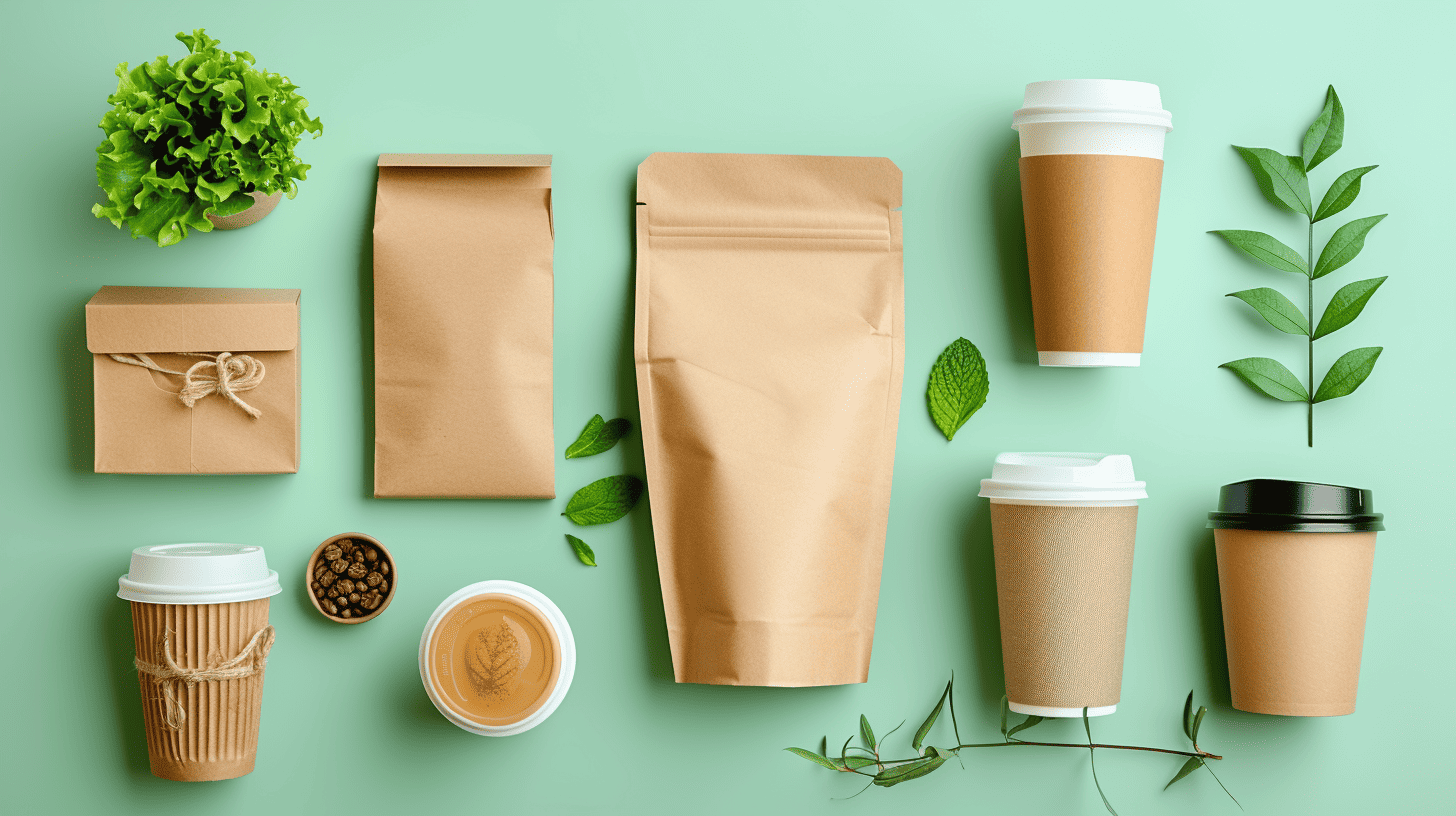I’m excited to discuss the variety of biodegradable packaging alternatives available for businesses striving to minimize their environmental footprint. The shift away from traditional plastic and towards eco-friendly options is more than just a trend—it’s a necessary step towards a sustainable future. A variety of inventive materials have entered the market, offering practical and green solutions that resonate with environmentally conscious consumers.
From compostable mailers made of cassava to cornstarch-based packaging that rivals conventional plastic, and recyclable paper bubble wrap that provides the cushioning needed to protect fragile items during transit, there are numerous ways to incorporate sustainable materials into your business operations.
Additionally, biodegradable foam chips, which dissolve in water without leaving toxic traces, serve as an excellent replacement for traditional polystyrene packing peanuts.
Key Takeaways
- Biodegradable packaging alternatives are essential for businesses looking to reduce their environmental impact.
- Options like compostable mailers, cornstarch packaging, and paper bubble wrap provide sustainable alternatives to traditional plastic packaging.
- Biodegradable foam chips can replace traditional polystyrene packing peanuts, dissolving in water without leaving toxic residues.
- Adopting eco-friendly packaging solutions supports consumer demand for sustainable products and business practices.
- Innovative materials and smart design choices help businesses make significant strides toward a more sustainable future.
21 Sustainable Packaging Alternatives
1. Corrugated Cardboard
- Statistics: Corrugated cardboard accounts for the largest portion of all paper recycling, with a recycling rate over 90% in the US. It’s biodegradable, lightweight, customizable, and cost-effective.
- Tips: Choose cardboard made with high recycled content. Optimize box size to product dimensions to reduce materials. Consider water-based inks for printing.
2. Recycled Paper
- Statistics: Recycled paper reduces waste sent to landfills by 60-70%, uses 60% less energy, and creates 74% less air pollution compared to virgin paper production3.
- Tips: Look for paper with high post-consumer recycled content. Use paper cushioning instead of plastic fill. Print on paper using vegetable-based inks.
3. Glass
- Statistics: Glass is 100% recyclable and can be recycled endlessly without loss in quality or purity4. The US recycles 33% of glass containers.
- Tips: Choose clear or green glass which are more commonly recycled colors. Consider switching labels to paper-based. Reuse glass containers.
4. Aluminum
- Statistics: Aluminum can be recycled repeatedly, and 75% of all aluminum ever produced is still in use. Recycling aluminum saves 95% of the energy needed to produce new aluminum7.
- Tips: Encourage customers to return/reuse aluminum containers through deposit programs. Use minimal ink when printing directly on aluminum.
5. Paper Pulp Containers
- Statistics: Containers made from paper pulp generate 68% less greenhouse gases compared to plastic versions.
- Tips: Choose unbleached and uncoated paper containers for improved recyclability. Consider biodegradable or paper-based lids/closures.
6. PLA (Polylactic Acid)
- Statistics: PLA bioplastics decompose in industrial composters and reduce fossil fuel use by 30-60% compared to plastic.
- Tips: Look for PLA made from plant starches like corn or sugarcane. Clearly label as commercially compostable.
7. Mushroom Packaging
- Statistics: Packaging made from agricultural waste and mushroom mycelium is compostable and biodegradable.
- Tips: Choose vendors like Ecovative that minimize synthetic additives. Customize with natural dyes.
8. Reusable Shipping Containers
- Statistics: Reuse reduces waste and energy use from raw material extraction and production by 85-95%.
- Tips: Opt for durable, reusable containers. Offer prepaid return shipping labels. Clean and reuse containers.
9. Compostable Mailers
- Statistics: Compostable mailers made from plants break down into organic matter instead of microplastics that pollute oceans.
- Tips: Look for locally compostable options like cellulose or PLA lined kraft paper. Clearly label as compostable.
10. Recycled Plastic
- Statistics: Recycling plastic saves twice as much energy as burning it in an incinerator. Global plastic recycling is only at 9% but increasing.
- Tips: Choose HDPE or PET plastic with high recycled content. Print directly on plastic using laser marking to improve recyclability.
11. Biodegradable Foam Chips
- Statistics: Biodegradable foam chips made from starches fully decompose in 90 days in home composters. They prevent product damage like conventional foam.
- Tips: Ensure foam does not contain synthetic additives. Opt for unbleached and uncolored foam.
12. Paper Tape
- Statistics: Paper tape is recyclable and compostable, unlike plastic tapes which end up in landfills and oceans.
- Tips: Use unbleached, non-coated kraft paper tape printed with vegetable inks. Consider water activated or starch-based adhesive.
13. Glassine Paper
- Statistics: Glassine paper is made from recycled paper pulp and is further recyclable17. It is biodegradable and heat/grease resistant.
- Tips: Request glassine paper made with high post-consumer recycled content. Print using vegetable-based inks.
14. Biodegradable Starch Peanuts
- Statistics: Starch peanuts dissolve in water and degrade naturally, unlike conventional foam peanuts.
- Tips: Verify starch peanuts are non-GMO and contain no synthetic additives. Compost used peanuts instead of disposing.
15. Plant-Based Cushioning
- Statistics: UFP Technologies produces 100% biodegradable, plant-based Endurapack cushioning. It protects as well as plastic bubble wrap.
- Tips: Ensure plant cushions do not contain polyurethane or other synthetics. Print plant cushions using water-based inks.
16. Recyclable Insulated Shipping Containers
- Statistics: Insulated containers keep products cool while recycling 10x more plastic than alternatives20. They use 60-80% recycled content.
- Tips: Look for sturdy containers to enable reuse. Use recyclable gel packs instead of single-use ice packs.
17. Edible Packaging
- Statistics: Edible seaweed, milk protein, and other biodegradable films reduce food waste from spoilage and unnecessary packaging.
- Tips: Request food-grade, plant-based films. Compost after use. Clearly communicate edibility to customers.
18. Returnable Totes
- Statistics: Reusable plastic totes eliminate cardboard waste, reduce transport emissions by 20%, and carry up to 50% more product.
- Tips: Look for sturdy foldable containers with high recycled content. Provide prepaid return shipping. Clean and reuse.
19. Recyclable Insulation
- Statistics: Recycled denim and cotton insulation offers similar insulating properties as conventional materials but is fully recyclable.
- Tips: Ensure 100% recycled and recyclable insulation. Print cotton insulation with non-toxic dyes.
20. Water Soluble Support Material
- Statistics: Water soluble support structures reduce material use and waste by up to 60% compared to traditional plastic supports.
- Tips: Support structures and surplus powder dissolve in tap water for disposal. Ensure powders are non-toxic.
21. Laser Marking Directly onto Products
- Statistics: Laser marking onto products prevents label waste and ensures 100% recyclability compared to paper or plastic labels.
- Tips: Customize logos, branding, and instructions directly onto glass, metal, plastic, or wood materials with a laser.
The Growing Importance of Eco-Friendly Packaging in Business
The necessity of reducing environmental impacts on a business-wide scale cannot be overstated. By understanding the full life cycle of product packaging and its associated carbon footprint, businesses can make informed decisions to embrace eco-friendly alternatives.
Understanding the Environmental Impact of Traditional Packaging
Traditional packaging methods, with their reliance on materials like plastic and polystyrene, present significant ecological challenges from production to transportation and disposal. As the negative environmental impacts of these materials become more apparent, businesses must reevaluate their packaging choices and consider sustainable packaging materials as viable options.
Businesses Responding to Consumer Demand for Sustainability
Responding to the increasing customer demand for sustainable practices, companies are shifting towards employing recyclable materials, reducing single-use plastics, and innovating with plant-based packaging solutions. Eco-friendly packaging alternatives not only cater to consumer preferences but also demonstrate a company’s commitment to environmental sustainability.
The Benefits of Adopting Green Packaging Practices
Adopting green packaging practices extends beyond just environmental stewardship; it positions a business as a forward-thinking leader, attracts eco-conscious consumers, and potentially avoids environmentally related taxes and penalties. Recyclable and biodegradable materials not only alleviate the ecological burden but can also align with brand messaging, creating memorable customer experiences and fostering loyalty among environmentally conscious clientele.
Biodegradable Packaging Alternatives for Businesses
I’m thrilled to introduce a host of biodegradable packaging options that stand as formidable allies in the face of environmental challenges posed by conventional packaging. Apart from biodegradable foam chips and paper bubble wrap, businesses now have access to an array of progressive, eco-friendly alternatives that enhance both product protection and brand reputation.
Shopify suggests using compostable packaging and mailers as a part of their eco-friendly packaging tips, highlighting the importance of materials that leave minimal environmental footprints.
One such innovation is cornstarch packaging. Cornstarch-based materials present a versatile and practically indistinguishable alternative to polystyrene, suitable for a diversity of industries, including food and pharmaceuticals. Another sustainable option includes paper tapes for sealing packages which come in various types to match business needs.
Furthermore, biodegradable plastic pallets exhibit remarkable reuse potential, defying the common assumption that all plastics inherently harm the environment. When managed correctly, certain plastics can endure countless cycles of use, presenting a cost-effective and surprisingly sustainable alternative for packaging needs.
- Compostable mailers: These eco-friendly packaging options provide a green solution for businesses looking to ship their products in a sustainable manner.
- Biodegradable materials: From starch-based packing peanuts to plant-based alternatives like cornstarch and cassava, these innovative materials offer a sustainable solution without compromising on product protection.
- Sustainable material sourcing: By choosing materials derived from renewable resources, like bamboo, businesses can reduce their environmental footprint while still ensuring product safety and quality.
These sustainable packaging alternatives offer a wide range of options for businesses looking to minimize their environmental impact. As the demand for eco-friendly packaging continues to grow, businesses have the opportunity to stay ahead of the curve and make a positive change towards a greener future.
Innovative Materials: Emerging Trends in Sustainable Packaging

The packaging industry is evolving at an incredible pace, with plant-based options leading the forefront of this renaissance. Materials like cornstarch and cassava are pioneering a new wave of biodegradable packaging alternatives, offering the insulating properties essential for delicate deliveries without the environmental toll associated with traditional plastic. Let’s explore some of these innovative materials and their impact on the future of sustainable packaging.
Plant-Based Options: Cornstarch and Cassava
Two strong contenders in the race to create sustainable packaging materials are cornstarch packaging and cassava-based mailers. Cornstarch packaging offers an environmentally friendly and versatile alternative to traditional plastics and polystyrene, and it is ideal for food, pharmaceuticals, and cosmetics industries. Similarly, cassava-based mailers provide a compostable packaging solution that decomposes in a home compost setting, leaving no harmful residues behind.
Edible and Soluble Choices: Future of Packaging
The challenge to create even more eco-friendly packaging materials has led to the exploration of edible packaging and soluble packaging. These innovative solutions not only reduce waste but also intrigue consumers with their novelty. While still in development, such materials have the potential to revolutionize the packaging industry and further minimize the environmental impact of consumer products.
Compostable Mailers and Their Effectiveness
Moving beyond traditional mailing options, compostable mailers have emerged as a popular and effective eco-friendly packaging solution. Cassava-based mailers, for instance, champion the closed-loop system crucial for sustainable living, requiring only a home compost setting to break down. By utilizing plant-based materials and innovative design, compostable mailers deliver an attractive and environmentally responsible alternative to conventional mailing options.
Smart Design Choices for Reducing Environmental Footprint

Smart design choices in packaging can lead to a substantial reduction in a business’s environmental footprint. By embracing minimalistic packaging approaches, focusing on repurposable and reusable options, and adopting carbon-neutral shipping practices, companies can create meaningful change in the battle against packaging waste while maintaining a strong economic and aesthetic presence.
Minimalistic Packaging: Less is More
Innovative eco-friendly packaging design often involves adhering to the principle of “less is more.” By adopting minimal packaging strategies, businesses can reduce material usage, leading to a decreased environmental impact, less waste in landfills, and a subtler, refined aesthetic that appeals to modern consumers.
Repurposable and Reusable Packaging Solutions
Emphasizing reusable packaging options allows businesses to minimize the amount of single-use materials that enter the ecosystem. Innovative uses of recyclable materials such as glass, metal, and reusable plastic can serve multiple purposes and be easily repurposed by end-users. By offering convenient and multi-functional packaging, companies take a step toward long-term environmental responsibility and create lasting, positive impressions on consumers.
Adjusting Shipping Methods for Lower Emissions
Carbon-neutral shipping practices contribute to a company’s overall mission to lower its environmental footprint. Examples include offsetting emissions by investing in renewable energy projects or choosing transportation methods that have a smaller geocarbon impact. Consolidating shipments can also reduce trip frequency while utilizing vacuum sealing and other size-reduction technologies for packaging helps limit emissions related to transportation.
By considering green packaging methods like minimal and reusable packaging designs and implementing carbon-neutral shipping practices, businesses can commit to environmental responsibility while preserving the effectiveness and attractiveness of their products and overall brand.
Conclusion on Biodegradable Packaging Alternatives for Businesses
As the sustainable packaging industry continues to evolve, businesses now have access to an ever-growing assortment of eco-friendly packaging materials and sustainable packaging solutions that present golden opportunities to significantly reduce their environmental impact. Embracing biodegradable materials such as cornstarch and cassava, innovative trends like edible packaging, and compostable mailers enables companies to align with consumer demand for sustainability and actively contribute to the broader ecological movement.
Smart design choices around minimalism and reuse, coupled with environmentally conscious packaging options, further enhance a business’s ability to limit its carbon footprint. The diversity and availability of recyclable and biodegradable packaging alternatives cater to the unique needs and values of businesses of all sizes, with far-reaching positive implications for the environment, customer perception, and the company’s sustainability.
With the future of the packaging industry focused on eco-friendly alternatives and sustainable shipping, it’s an exciting time for businesses poised to invest in this indispensable market transformation. As a professional copywriting journalist, I genuinely look forward to witnessing how companies continue to innovate and grow within this crucial shift toward sustainable business practices.
FAQ on Eco-Friendly Packaging Alternatives
Q: What are some eco-friendly packaging alternatives for businesses?
A: Some eco-friendly packaging alternatives for businesses include recycled materials, compostable packaging, mushroom packaging, and biodegradable packaging peanuts.
Q: How can I reduce the use of plastic in packaging?
A: You can reduce the use of plastic in packaging by using alternatives such as cardboard, cornstarch packaging, recycled plastic, and biodegradable materials.
Q: What are some sustainable packaging materials that I can use for my products?
A: You can use sustainable packaging materials like recycled cardboard, compostable materials, recycled plastics, and mushroom packaging for your products.
Q: What is the benefit of using recycled materials for packaging?
A: Using recycled materials for packaging reduces the demand for new raw materials, conserves resources, and minimizes waste going to landfills.
Q: How can small businesses implement sustainable packaging practices?
A: Small businesses can implement sustainable packaging practices by opting for eco-friendly alternatives to plastic, using recycled and biodegradable materials, and offering custom packaging solutions.
Q: What are some packaging ideas for eco-friendly businesses?
A: Some packaging ideas for eco-friendly businesses include using recycled cardboard, biodegradable air cushioning material, compostable packaging, and biodegradable packing peanuts.
Q: Can sustainable packaging alternatives help grow my business?
A: Yes, sustainable packaging alternatives can help grow your business by attracting eco-conscious customers, reducing environmental impact, and enhancing brand image.
Q: How can I find a guide to sustainable packaging for my business?
A: You can find a guide to sustainable packaging for your business through industry resources, sustainability organizations, and packaging suppliers specializing in eco-friendly solutions.
Q: Are there alternatives to bubble wrap and plastic packaging peanuts?
A: Yes, alternatives to bubble wrap and plastic packaging peanuts include compostable materials, recycled cardboard, mushroom packaging, and biodegradable packing peanuts.
Q: What are some sustainable packaging materials suitable for ecommerce businesses?
A: Sustainable packaging materials suitable for ecommerce businesses include corrugated cardboard, recycled plastics, biodegradable air cushioning material, and compostable packaging options.





Leave a Reply